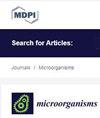AoRan1 Is Involved in Regulating Conidiation, Stress Resistance, Secondary Metabolism, and Pathogenicity in Arthrobotrys oligospora
IF 4.1
2区 生物学
Q2 MICROBIOLOGY
引用次数: 0
Abstract
Arthrobotrys oligospora is a representative nematode-trapping (NT) fungus that is able to capture, kill, and digest nematodes by producing specialized three-dimensional networks (traps) under nutrient-deprived conditions. Ran1 is a serine/threonine protein kinase that can act as a negative regulator of sexual conjugation and meiosis. However, the specific role of Ran1 remains largely unknown in NT fungi. Here, we identified AoRan1 (AOL_s00004g277) via gene disruption, phenotypic analysis, and metabolomic analysis. Our findings reveal that Aoran1 knockout caused a remarkable increase in conidial production, traps, and nematode feeding efficiency. In addition, the absence of Aoran1 resulted in the accumulation of lipid droplets and increased autophagic levels as well as increased tolerance to cell wall synthesis-disturbing reagents and oxidants. Metabolomic analyses also suggested that AoRan1 is involved in multiple metabolic processes, such as fatty acid biosynthesis. In summary, our results suggest that AoRan1 is crucial in conidiation, pathogenicity, and secondary metabolism. This study’s results further our understanding of the molecular mechanisms by which AoRan1 regulates conidiation and trap formation in A. oligospora.AoRan1 参与调控寡孢子节肢动物的分生、抗应激、二次代谢和致病性
Arthrobotrys oligospora 是一种具有代表性的线虫诱捕(NT)真菌,它能够在营养缺乏的条件下通过产生特化的三维网络(诱捕器)来捕获、杀死和消化线虫。Ran1 是一种丝氨酸/苏氨酸蛋白激酶,可作为有性结合和减数分裂的负调控因子。然而,Ran1在NT真菌中的具体作用在很大程度上仍然未知。在这里,我们通过基因干扰、表型分析和代谢组学分析鉴定了 AoRan1(AOL_s00004g277)。我们的研究结果表明,Aoran1 基因敲除可显著提高分生孢子的产量、捕获率和线虫的摄食效率。此外,缺失 Aoran1 会导致脂滴积累、自噬水平提高以及对细胞壁合成干扰试剂和氧化剂的耐受性增强。代谢组分析还表明,AoRan1 参与了多种代谢过程,如脂肪酸的生物合成。总之,我们的研究结果表明,AoRan1 在分生、致病和次生代谢过程中至关重要。这项研究结果进一步加深了我们对 AoRan1 调控寡孢子菌分生和诱捕器形成的分子机制的理解。
本文章由计算机程序翻译,如有差异,请以英文原文为准。
求助全文
约1分钟内获得全文
求助全文
来源期刊

Microorganisms
Medicine-Microbiology (medical)
CiteScore
7.40
自引率
6.70%
发文量
2168
审稿时长
20.03 days
期刊介绍:
Microorganisms (ISSN 2076-2607) is an international, peer-reviewed open access journal which provides an advanced forum for studies related to prokaryotic and eukaryotic microorganisms, viruses and prions. It publishes reviews, research papers and communications. Our aim is to encourage scientists to publish their experimental and theoretical results in as much detail as possible. There is no restriction on the length of the papers. The full experimental details must be provided so that the results can be reproduced. Electronic files and software regarding the full details of the calculation or experimental procedure, if unable to be published in a normal way, can be deposited as supplementary electronic material.
 求助内容:
求助内容: 应助结果提醒方式:
应助结果提醒方式:


